In the past 10 years there has been a dramatic increase in different wrist and elbow pain conditions. Largely, it has happened due to an increased pressure on the upper extremities. We are always working on our computers, browsing or chatting with our smartphones. Blogging, tweeting, posting, and emailing have become our daily routine. Meanwhile, how often do we stretch and warm up our hands or elbow muscles?
Lateral epicondylitis, more commonly known as tennis elbow, is the result of repeated contraction of the muscles used to extend (straighten) the arm and raise the hand. Pain typically occurs on the outside of the elbow.
Repetitive overuse is only part of the problem. It is truly a combination of factors of equal important some of which are:
- Prolonged finger loads
- Static forces
- Inadequate postural support of the spine and shoulder blades.
Why is that some people develop these musculoskeletal illnesses when colleagues who are doing exactly the same activities do not?
Different risk factors can predispose an individual to develop these musculoskeletal syndromes. They are:
- Postural support of the axial organ (Spine, shoulder and pelvic girdle complex) plays a key role in distribution of forces throughout upper extremity. In other words, inadequate support of the shoulder blades on the spine causes further peripheral imbalance into muscles traveling across multiple joints of shoulder, elbow and wrist . Scientific evidence and practical experience shows us that recovery time of treatment for wrist and elbow syndromes are much abbreviated when stability of shoulder blades is addressed.
- Tissue texture quality plays an important role in development of musculoskeletal conditions of upper extremities. Women are usually more affected with painful syndromes of wrist and elbow due to different hormonal profile, which negatively affects tissue tensile quality.
- Orthopedic structural variations also predispose people to these painful conditions. Some examples are: abnormal shapes of shoulder blade bones, variations in shape of acromium ( hook of the shoulder blade), increased angle of the elbow joint, elbow dysplasias , shallow wrist arch.
- Generalized hypermobility, which affects the whole body as well as dynamic support of joint of upper extremity.
- There could also be some personal factors like diabetes or obesity.
To reiterate, the repetitive overuse syndromes in upper extremity are multifactorial disorders in which only the synergic action of various risk factors can push the individual over the threshold of clinical symptoms.
It is of the critical importance that activity moderation and modification is instituted together with physical therapy, as conservative approach is only affective during the early stages of the disease. Frequently patients tend to ignore the symptoms in the early stages further aggravating tendon/muscle dysfunction leading to chronicity and disability.
Unfortunately, surgical approaches in the upper extremity often offer less then satisfactory results due to:
- Increased sensitivity of the patient
- Complicated anatomy of the region
- Increased use of upper extremities
Biological treatments like Extracorporeal Shockwave therapy show good results in combination with rehabilitation and activity moderation for some indications of elbow and wrist pain disorders.
However, best results are truly achieved when elbow pain disorders are treated early on and with best possible compliance to activity moderation.



























































